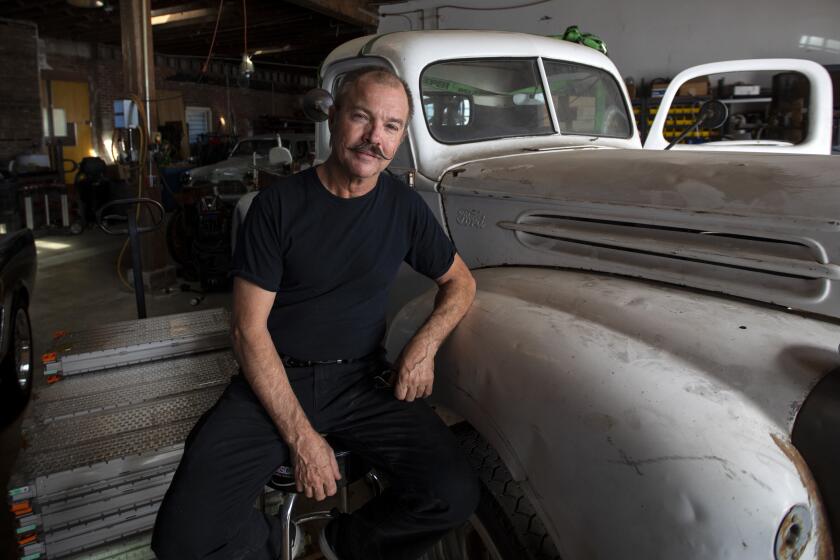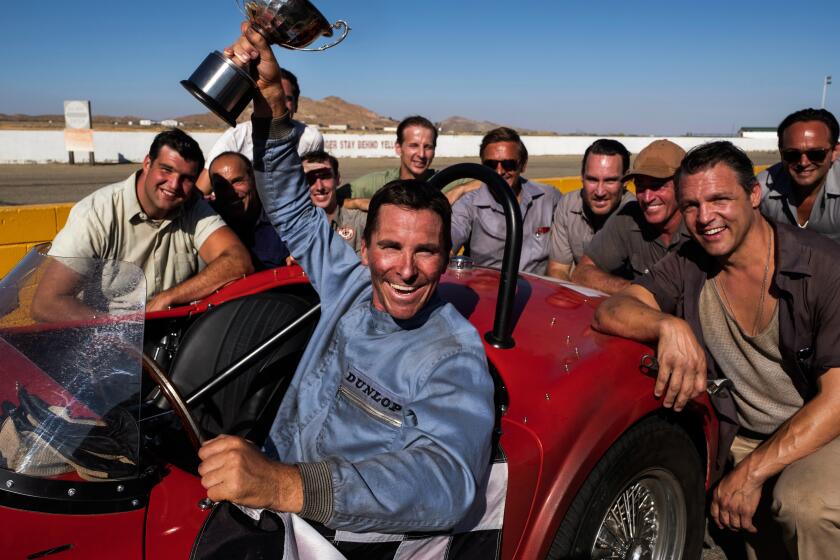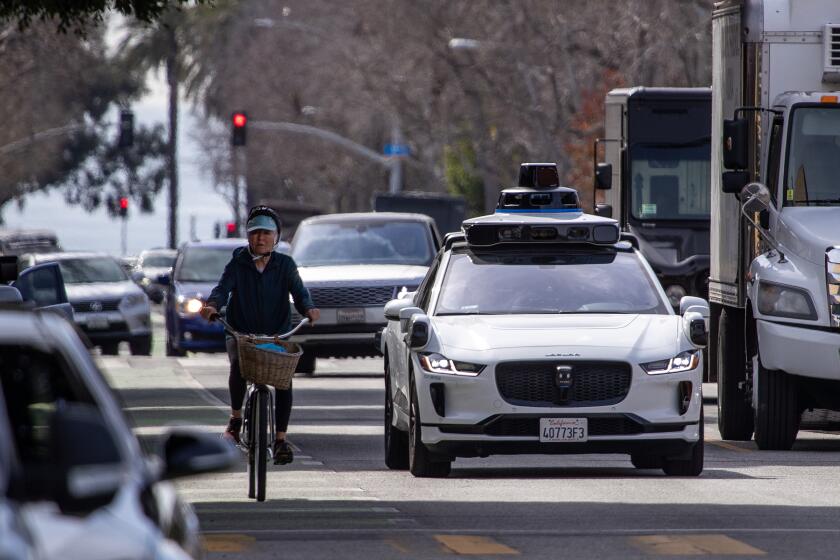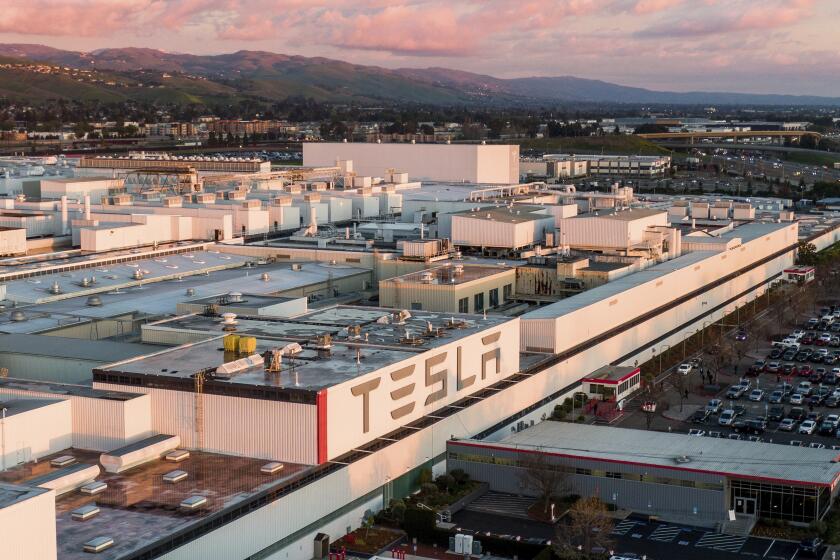Driven: Ford ponies up on electric vehicles with a Mustang-inspired SUV
- Share via
Hawthorne, Calif., seems an unlikely spot for an auto industry showdown. But it was here on Sunday night that Ford Motor Co. unveiled its first new-from-the-ground-up fully electric vehicle, the Mustang Mach-E.
The event took place in a hangar just a stone’s throw from Tesla’s design center, where in a few days that EV pioneer will throw its own party for a much-anticipated pickup truck. Tesla’s truck will aim squarely at Ford’s F-150, which has been the best-selling pickup in the U.S. for more than four decades.
Ford is pulling out all the stops with the Mach-E, an SUV with a strong family resemblance to the Mustang, the world’s best-selling sports coupe and a muscle-car icon since its launch in 1964. From the arching, coupe-like roofline to beefy rear haunches and the familiar tri-bar headlights and taillights, the Mach-E’s relationship to its stablemate is clear. The Mach-E also bears the pony badge, rather than a Ford blue oval, to drive the point home.
Some Mustang loyalists are complaining that Ford has committed sacrilege by not only electrifying the ’Stang but worse, turning it into a four-door crossover people-carrier. I’ll argue that it’s simply smart business to expand a beloved nameplate into a broader product lineup that includes the high-demand SUV category. Porsche fans felt the same way when the German automaker launched the Cayenne SUV, now a top seller. And this recognizes that Ford is now down to producing a small number of passenger cars.
Porsche is taking on Tesla and all other would-be electric sports cars with its new Taycan.
By creating a new Mustang family member, Ford took its investment in EVs — the company has committed to spending more than $11 billion by 2022 to do its part for the environment, including EV versions of the F-150 and Transit cargo van — in a bold rather than bland direction.
The Mustang lineage is more than skin-deep: Ford has focused on performance too. Two electric motors independently power the front and rear wheels, and both rear-wheel drive and all-wheel drive options will be available. The base Mach-E will have the equivalent of 332 horsepower and 417 pound-feet of torque. The top-end GT variant will pack a massive 459-horsepower equivalent and 612 pound-feet of torque — far more grunt than an F-150 can claim. Ford says the GT is capable of 0 to 60 in the mid-three-second range.
You can get there in any of the Mach-E’s three drive modes: “whisper,” “engage” and “unbridled.” All three had scores of sound engineers researching and working to distill 30 possible sounds down to a few brand-appropriate ones, including the all-important E-equivalent of the Mustang’s classic, gas-drenched rumble for the “unbridled” mode.
The Mach-E will offer as much as 300 miles of range in rear-wheel drive dress and with the optional extended-range package. Other editions will have a minimum range of 230 miles.
Through Ford’s FordPass app, owners will have access to 12,500 charging stations across the U.S. The company has already EV-trained more than 2,100 dealerships and 3,500 technicians, with more coming. Ford has even partnered with Amazon to allow buyers to purchase home chargers online that Amazon’s delivery teams will install in your garage — and that will also carry Amazon’s 90-day satisfaction guarantee.
A growing army of hot rodders is cannibalizing crashed electric cars and turning them into custom vehicles with electric power trains.
To aid customers in finding those charging stations and planning their route time accurately to include charging stops, Ford has put its next-gen Sync technology into the Mach-E. That offers 100% cloud-based connectivity enabling real-time updates. Owners can access it all through the enormous, 15.5-inch vertical center touch screen (sound familiar?). The company says that Sync’s algorithms quickly adapt to an owner’s preferences, schedules and favorite apps. And the Mach-E will be equipped to over-the-air software updates, another Tesla-esque feature.
One old-school touch: a digital gauge cluster just where a driver is used to seeing it, right above the steering wheel. Sometimes when it works for buyers, don’t fix it.
There are five versions to choose from: the base Select in rear-wheel and all-wheel drive (from $34,895); a limited-run, all-wheel-drive-only First Edition (from $59,900); Premium (from $50,600); California Route 1 extended-range, rear-wheel drive (from $52,400); and GT, which gets a massive power and performance upgrade (from $60,500).
For now, there’s still a potential $7,500 federal tax credit too. And for the first time, Ford is offering interested consumers the ability to place a refundable $500 deposit online via a dedicated Mach-E site to reserve a vehicle. (EV-trained dealers can accept deposits too.) Ford will begin delivering vehicles late next year, with the high-performance GT edition showing up closer to the spring of 2021.
Ford’s EV move bears a resemblance to historical roots. The film “Ford v Ferrari” captures the heated rivalry between Henry Ford II and Enzo Ferrari in the 1960s, when Ford wrote a more-or-less blank check to a scrappy, rebellious yet talented band of motorsports experts led by Carroll Shelby to build a race car to beat the Italians on the global endurance sports-car racing stage. The result was the multi-winning Ford GT40.
I’ll posit that creating a Mustang SUV, and electric to boot, was just about as bold and daring a move as Ford II’s greenlighting Shelby to reinvent sports-car racing.
When director James Mangold’s new movie “Ford v Ferrari” hits theaters Nov. 15, car nuts may find themselves asking where the filmmakers found all those classic Carroll Shelby race cars from the 1960s, which sell for millions of dollars when they become available.
In 2017, thanks in large part to executive vice president, president of global markets and self-identified hopeless car lover Jim Farley, Ford invested in what amounted to a start-up within the company, internally called Team Edison. Set apart from the Ford campus in a building in downtown Detroit, the cross-functional team includes designers, engineers, marketing experts and software specialists, among others. Some are lifelong Ford executives with global experience. Others are former bankers, dot-com entrepreneurs, a musician, an aerospace engineer and one rocket scientist who put a satellite into Mars’ orbit.
Their mission was, and is, to change the way a whole new vehicle could be imagined, tested and put into production — faster, better and smarter than the company’s existing complex pipelines are able to.
The team quickly saw that the company’s need for a “compliance” EV — a vehicle built in enough volume to satisfy regulators’ high bars for emissions going forward — wasn’t going to win them fans, let alone key market share, in the increasingly crowded EV space.
“We realized that we needed to play to our strengths: SUVs, performance cars, pickups and commercial vehicles,” said Ted Cannis, Ford’s global director of electrification. “Compliance vehicles are not iconic, and we saw that that is where our focus needed to be.”
Key to the team’s pivot to the Mustang vision was Jason Castriota, first the head of the Mach-E project and now the global brand director for battery electric vehicles, who joined Ford in 2016 as chief of global advanced design. Soon after he joined, at his request and with Ford’s help and blessing, he earned a degree in marketing from the Ross School of Business at the University of Michigan — making him the first Ford design employee to do so.
“Jason was a critical part of us turning in this new, more aspirational direction,” Cannis said.
The Chinese-owned carmaker from Sweden wants to add “sustainability” to its reputation for safety
Castriota brings to Ford and Mach-E his experience as one of the most successful supercar and hypercar designers of our times. In the early 2000s, he became the youngest head designer at Pininfarina. While there, he penned, among others, the Ferrari 599 GTB Fiorano and the Maserati GranTurismo.
“I’ve been so fortunate to realize my childhood dream and create what are, for most, unattainable exotic cars fueled by my passion,” Castriota said. “By coming to Ford, I’m fulfilling my other long-term desire: to bring that same level of automotive emotion and thrill to people at a far more realistic price point.” (There’s much more to tell about Castriota and his extreme machines, as I will explain in my next column.)
I’m not here to tell you that Ford has won just yet. I haven’t even driven a Mach-E myself, although I was an impressed passenger for a few high-speed, closed-track minutes with a pro Mustang race driver behind the wheel of a prototype.
But if it fulfills all that it has promised on the Mach-E — which in turn informs how it will handle its next EVs, starting with the F-150 — Ford has a more than decent shot in an already overcrowded space. For while Tesla and far bigger competitors — GM, Toyota, Volkswagen Group, to name a few — are churning out EVs, most of those are not built on the back of decades-long model success stories.
It’s all in the execution. For Ford, and everyone else.
More to Read
Inside the business of entertainment
The Wide Shot brings you news, analysis and insights on everything from streaming wars to production — and what it all means for the future.
You may occasionally receive promotional content from the Los Angeles Times.












